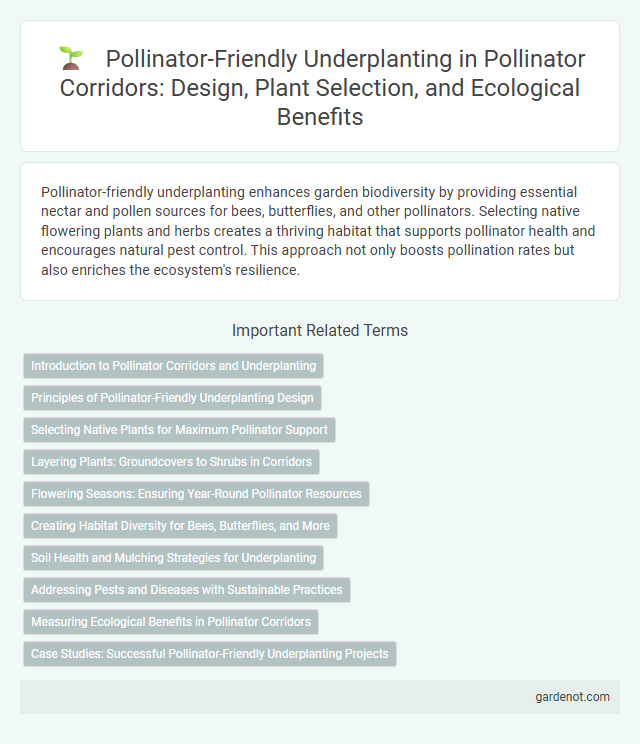Pollinator-friendly underplanting enhances garden biodiversity by providing essential nectar and pollen sources for bees, butterflies, and other pollinators. Selecting native flowering plants and herbs creates a thriving habitat that supports pollinator health and encourages natural pest control. This approach not only boosts pollination rates but also enriches the ecosystem's resilience.
Introduction to Pollinator Corridors and Underplanting
Pollinator corridors enhance biodiversity by creating continuous habitats that support pollinators such as bees, butterflies, and hummingbirds. Pollinator-friendly underplanting incorporates native flowering plants beneath trees and shrubs to provide essential nectar and pollen resources throughout growing seasons. This strategic layering of vegetation improves habitat connectivity, boosts pollinator population resilience, and promotes ecosystem health in urban and rural landscapes.
Principles of Pollinator-Friendly Underplanting Design
Pollinator-friendly underplanting design prioritizes diverse native flowering plants that bloom at staggered intervals to provide continuous nectar sources throughout the growing season. Incorporating a variety of plant heights and structures creates microhabitats that support differing pollinator species, including bees, butterflies, and hoverflies. Soil health and minimal pesticide use are essential principles that enhance habitat quality and promote sustainable pollinator populations.
Selecting Native Plants for Maximum Pollinator Support
Selecting native plants for pollinator-friendly underplanting enhances biodiversity by providing essential nectar and pollen sources adapted to local pollinators. Native species such as milkweed, coneflowers, and goldenrod support bees, butterflies, and hummingbirds by offering continuous bloom cycles and habitat compatibility. Incorporating diverse plant structures and bloom times optimizes pollinator foraging efficiency and promotes ecosystem resilience in pollinator corridors.
Layering Plants: Groundcovers to Shrubs in Corridors
Pollinator-friendly underplanting in corridors enhances biodiversity by layering plants from groundcovers to shrubs, creating diverse habitats and nectar sources for bees, butterflies, and other pollinators. Groundcovers like clover and wild thyme improve soil health and provide continuous blooming periods, while mid-height shrubs such as elderberry and hawthorn offer shelter and critical forage. This stratified planting approach supports pollinator movement and nesting, contributing to the ecological resilience of pollinator corridors.
Flowering Seasons: Ensuring Year-Round Pollinator Resources
Pollinator-friendly underplanting includes selecting diverse native species that bloom sequentially from early spring to late fall, providing continuous nectar and pollen sources essential for bee and butterfly populations. Incorporating plants like early-blooming crocus, mid-season coneflowers, and late-fall goldenrod supports pollinator health and biodiversity throughout the year. Maintaining this floral succession enhances habitat resilience and strengthens pollinator corridors by bridging seasonal resource gaps.
Creating Habitat Diversity for Bees, Butterflies, and More
Pollinator-friendly underplanting enhances habitat diversity by incorporating native wildflowers, herbs, and ground covers that provide continuous nectar and pollen sources for bees, butterflies, and other pollinators. Strategic layering of vegetation with varying bloom times supports different pollinator species throughout the growing season, promoting ecosystem resilience and biodiversity. Integrating diverse plant species improves soil health, shelters nesting sites, and increases forage availability critical for sustaining robust pollinator populations.
Soil Health and Mulching Strategies for Underplanting
Pollinator-friendly underplanting enhances soil health by increasing organic matter, improving moisture retention, and supporting beneficial microbial activity essential for plant growth and pollinator nutrition. Mulching strategies involving natural, biodegradable materials such as leaf litter or wood chips suppress weeds, regulate soil temperature, and reduce erosion, creating an optimal environment for underplanted species. These practices foster a robust, nutrient-rich soil ecosystem that sustains diverse pollinator populations critical for ecological balance within pollinator corridors.
Addressing Pests and Diseases with Sustainable Practices
Pollinator-friendly underplanting enhances biodiversity by incorporating native flowering species that support beneficial insects while naturally deterring pests and diseases. Techniques such as companion planting with marigolds, nasturtiums, and aromatic herbs create habitats for predatory insects, reducing reliance on chemical pesticides. Employing organic mulches and maintaining soil health further strengthens plant resilience, promoting a sustainable and thriving pollinator corridor.
Measuring Ecological Benefits in Pollinator Corridors
Pollinator-friendly underplanting enhances biodiversity and supports native pollinator populations by providing continuous floral resources throughout the growing season. Measuring ecological benefits in pollinator corridors involves assessing pollinator abundance, species diversity, and habitat connectivity to gauge improvements in ecosystem health. Data from systematic surveys and remote sensing technologies quantify how underplanting contributes to pollination services, plant reproduction, and overall habitat resilience.
Case Studies: Successful Pollinator-Friendly Underplanting Projects
Case studies of pollinator-friendly underplanting projects demonstrate substantial increases in native bee populations and butterfly diversity within restored habitats. Projects incorporating diverse native wildflower species beneath tree canopies consistently enhance floral resource availability throughout growing seasons, supporting pollinator foraging and nesting. Effective underplanting designs balance plant species' bloom times and structural layers to create continuous, resilient pollinator corridors that improve ecosystem health and biodiversity.
Pollinator-friendly underplanting Infographic

 gardenot.com
gardenot.com